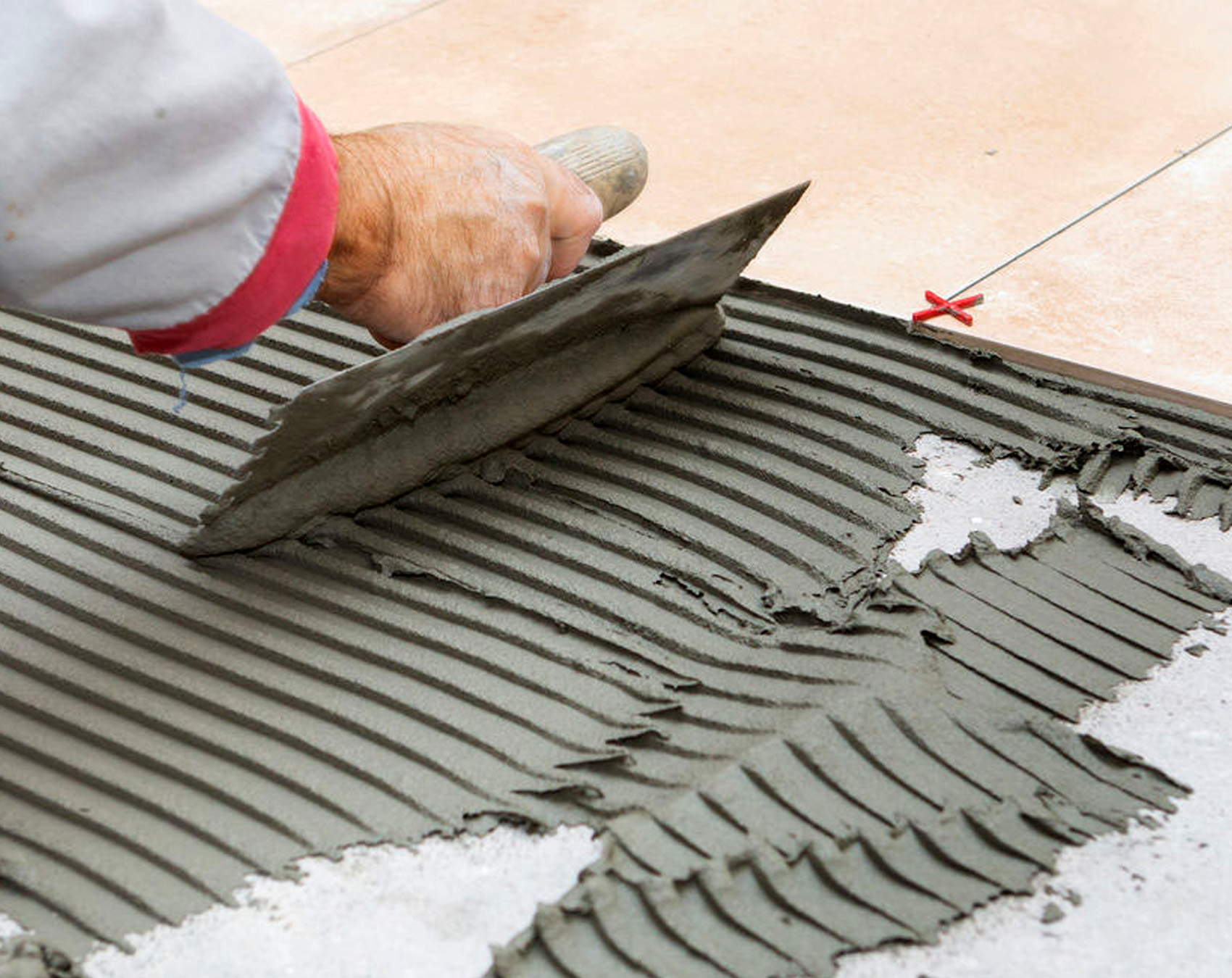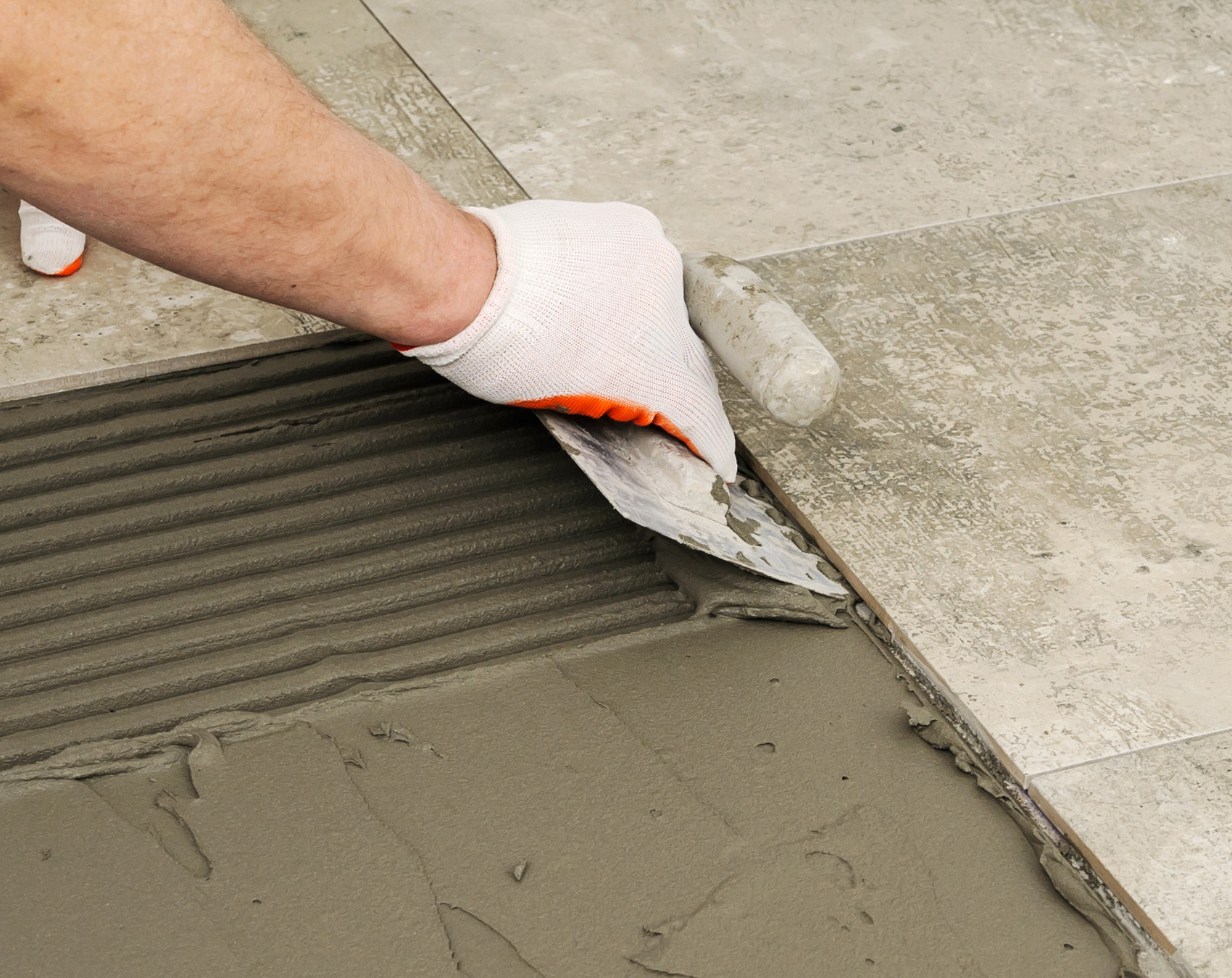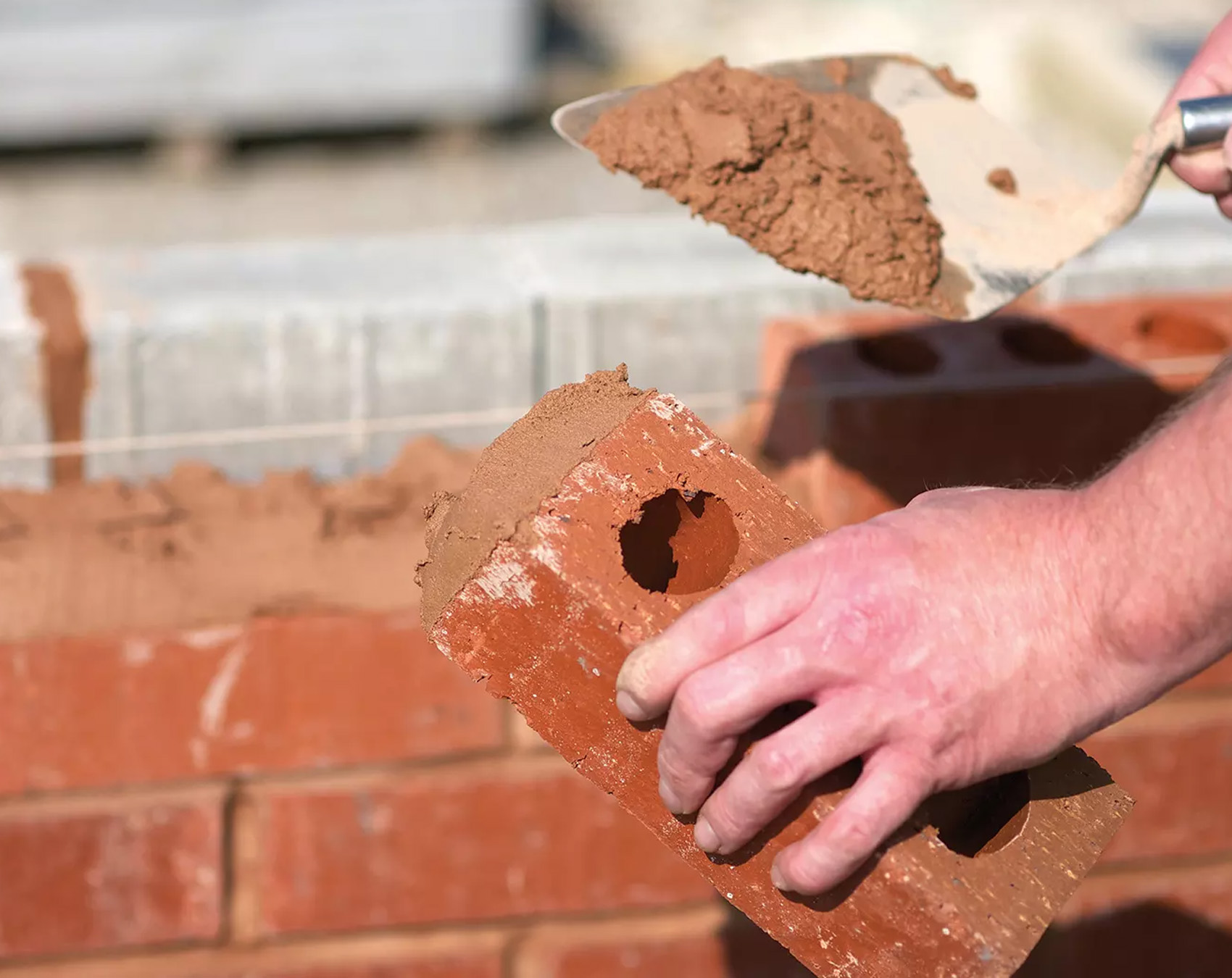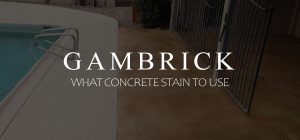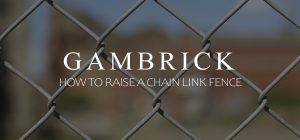How Long Does Mortar Take To Dry?
Mortar takes about 24 hours to dry and cure to 60% of its final compressive strength. It will then takes about 28 days to reach its full cure strength. However, exact cure times will vary based on the mix, site conditions, how much mortar was used, the weather and average temperature. Weather and temperature are very important factors when determining mortar’s cure time.
Mortaring tiles and other masonry units in place is a very important part of the construction industry. It’s used as a binding material for brick, stone, block and tile. Like concrete, mortar requires careful planning and execution to achieve the best possible cure strength and a strong bond between materials and/or the substrate.
Mortar is used to bind materials like stone, tile, block and brick together. It’s made by mixing cement and sand with water in varying amounts which are called mortar mix ratios. By varying the ratio of each ingredient, and adding additional ingredients to mortar, you can alter its properties.
Mortar is sometimes confused with cement. But it’s a different material that’s much thicker than cement when properly mixed. Knowing how to apply and spread mortar makes a big difference in any construction project you use it. The improper application of mortar can cause things like structural weakness, popped tiles and loose stones or brick.
Failure to let mortar dry and cure can cause major issues for your project. Adding too much weight onto wet mortar before it properly dries can shift tiles, bricks or stone that haven’t set in place yet.
So, how long does Mortar take to dry?
What Is Mortar?
Mortar is a mixture of sand and cement mixed with water to form a gritty paste like material. It’s most often used to build brick, stone or block walls or to set tile. In some cases mortar can be mixed with lime or other ingredients to alter its properties. This is called the mortar mix ratio. Mortar has a lower water content than grout and should only be mixed with enough water to create a smooth and buttery consistency.
Mortar is used to bond masonry materials like brick and stone together and provide structural integrity. It’s also used to set thinner materials like tiles or veneer to create a bond between the material and the substrate.
Mortar is applied when wet to brick, stone, block or tile. It’s then set and allowed to dry and cure. In the first 24 hours, mortar dries to about 60% of its final compression strength. However, it takes about 24 days to reach full strength.
Many factors effect how long it takes mortar to try which includes:
- Weather
- Materials its used with
- Additives
- Site conditions
- Temperature & humidity
- The mixture used & mortar type
- How thick it’s applied
It’s very important to properly mix, apply and dry mortar in order for it to reach full strength. Applying too much pressure to mortar before it fully cures can result in a weak bond and structural issues.
Drying Times For Different Types Of Mortar
As a builder with over 25 years experience, I’ve worked with just about every type of mortar on the market including custom mixes. I can tell you that drying times will vary based on the type of mortar you’re using, the job, weather, temperature and site conditions. There’s no set answer to the question “How Long Does Mortar Take To Dry.” But there are some general guidelines you can follow that are fairly accurate.
It’s important to keep in mind that these times are general guidelines and drying time can vary based on the specific product.
- Environmental factors like humidity and temperature play a big role in determining how long it takes mortar to dry.
- Always refer to the manufacturer’s instructions for specific drying time recommendations.
- While mortar may appear dry on the surface within the first few hours, it’s still important to wait a full 48-72 hours before walking on or grouting tiles or putting too much weight on a wall to ensure the mortar has fully cured and set.
- Rushing mortar’s dry time can compromise the bond between materials which can lead to shifting or movement over time.
By following these guidelines and allowing ample time for the mortar to dry and cure, you can ensure a strong bond and a successful project.
Here are some general guidelines for how long it takes for different types of mortar to dry and cure:
Cement-Based Mortar
Cement-based mortar is one of the most commonly used types of mortar. In general, you can expect it to take about 24-48 hours to dry to around 60% of its maximum compressive strength. But like other types of mortar, cement-based mortar takes around 28 days to reach full strength.
Keep in mind that this can vary depending on factors like humidity and temperature. In humid or colder conditions, drying time can be extended.
Epoxy Mortar
Epoxy mortar is a special type of mortar that’s often used with natural stone or in high-moisture areas like showers. It typically dries more quickly than cement-based mortar, with a drying time of around 12-24 hours to reach 60% of its maximum compressive strength and 28 days to reach full strength.
Pre-Mixed Mortar
Pre-mixed mortar is another option that can dry faster than traditional cement-based mortar. Drying time can vary depending on the specific product, but in general, you can expect pre-mixed mortar to dry within 12-24 hours to reach 60% of its maximum compressive strength and 28 days to reach full strength.
Thinset
Thinset is a type of mortar that’s typically used for installing tile and countertops. It’s also known as dry set or dry bond mortar. It usually contains a water retaining additive that helps with the curing and hydration process.
Thinset mortar takes between 24-48 hours to to reach 60% of its maximum compressive strength and 28 days to reach full strength. It’s sold in a variety of mixes that can be used to install a wide range of tiles and other materials.
Each type of material has different cure strength requirements so make sure to select the right mortar mix for your project.
Brick Mortar
Brick mortar is a type of cement-based mortar. It’s made from Portland cement and sand and is used for structural and load bearing projects. It takes between 24-48 hours to to reach 60% of its maximum compressive strength and 28 days to reach full strength.
There are 5 basic types of brick mortar, and they each dry and cure a little differently.
Type M
Type M mortar cures to a minimum compressive strength of 2500 psi. It’s the strongest type of mortar and used for structural projects that need to withstand extreme forces and hold heavy lateral loads. Things like large retaining walls and foundations typically use type m mortar. It takes around 12-24 hours to to reach 60% of its maximum compressive strength and 28 days to reach full strength.
Type S
Type S mortar is a medium strength mortar that cures to a minimum compressive strength of 1800 psi. It’s typically used on structural exterior projects where mortar comes in direct contact with the ground. Things like small retaining walls, patios and small foundations may use type s mortar. It takes around 18-24 hours to to reach 60% of its maximum compressive strength and 28 days to reach full strength.
Type N
Type N mortar is a very common general purpose mortar that cures to a minimum compressive strength of 750 psi. It’s commonly used for general masonry projects and interior non-structural work. It takes around 24 hours to to reach 60% of its maximum compressive strength and 28 days to reach full strength.
Type O
Type O is a low strength mortar that only cures to a minimum compressive strength of 350 psi. It’s only safe to use for non-load-bearing interior work, non-structural repairs, or on soft masonry like sandstone or brownstone. It takes around 24-48 hours to to reach 60% of its maximum compressive strength and 28 days to reach full strength.
Type K
Type K is the lowest strength mortar available and only cures to a minimum strength of 75 psi. It’s primarily used for historical preservation work on non-structural old and brittle stone and brick. It takes around 24-48 hours to to reach 60% of its maximum compressive strength and 28 days to reach full strength.
Factors That Affect Mortar Drying Time
Mortar will generally dry and cure to 60% of its maximum compressive strength within the first 24 hours. But it then takes about 28 days to reach its full cure strength. However the drying process doesn’t always follow a predetermined timeline. There are variables like weather, temperature and site conditions that affect how long it takes mortar to cure.
As someone with years of experience working with mortar, I can tell you that mortar rarely dries according to plan. You have to mix and apply it correctly and watch over it in order to get the best results.
Always keep in mind that there are many factors that can affect the drying time of mortar. By taking these factors into account and following the manufacturer’s instructions, you can ensure a strong bond and a successful project.
Here are some of the most common factors that effect how long it takes mortar to cure:
Type Of Material & Substrate
The type of material and the substrate you’re working on can have a significant impact on how long it takes for the mortar to dry. For example, if I’m laying porcelain tile on a concrete slab, I’ll typically use a cement-based mortar which can take longer to dry than other types of mortar. On the other hand, if I’m working with natural stone, I usually use a special type of epoxy mortar which dries faster than traditional cement-based mortar.
Always take the material and substrate into account when considering your mortar’s dry time.
Type Of Mortar & Coverage
The type of mortar you’re using can also affect drying time. Some mortars, like pre-mixed ones, may dry more quickly than others. The thickness of the mortar layer you apply can also impact drying time. A thicker layer of mortar will take longer to dry than a thinner one. Be sure to follow the manufacturer’s instructions when applying mortar.
Water
Always carefully follow the manufacturer’s guidelines for mixing ratios when it comes to water. Your mortar mixture must contain the correct amount of water to dry, cure and perform optimally. Using too much or too little water will change your mortar’s cure time and cure strength and make it difficult to work with.
Humidity & Temperature
The environment you’re working in can also impact the drying time of mortar. If you’re working in a humid environment, excess moisture in the air can slow down the drying process. Similarly, if you’re working in a colder environment, the lower temperature can slow down drying time as well.
Be sure to keep the area well-ventilated to help speed up the drying process. Also consider covering the mortar with plastic on extremely hot days to slow evaporation.
Normal temperatures for mortar are between 40°F-100°F (4.4°C-37.8°C). Cold weather is considered when ambient temperatures drop below 40°F (4.4°C).” When you work within the normal temperature range, you can expect your mortar to follow the typical cure timeline we discussed throughout the article.
Cold weather can slow construction by affecting the set time and strength development of mortar. If weather gets below 40°F (4.4°C) within 24 hours, hydration of the cement will stop until temperatures become warm enough for hydration to continue. This could significantly slow down how long it takes your mortar to cure.
In cases where the temperature will drop below 40°F (4.4°C), consider using warming blankets or heaters to keep the mortar warm.
Maintaining the right moisture levels is critical for your mortar’s cure time and final cure strength. That means paying attention to the moisture in the air.
- If you’re working in a low humidity environment, you may need to add a little moisture to assist in the curing process, especially if it’s windy.
- Working in high humidity can slow down the curing process.
Paying attention to both the amount of water used in the mortar mixture and external humidity are important to controlling dry and cure times.
Thickness Of The Mortar Layer
The thickness of the mortar layer you apply can also impact its drying time. A thicker layer of mortar will generally take longer to dry than a thinner one. Be sure to follow the manufacturer’s instructions when applying mortar.
AirFlow
How quickly mortar dries and cures depends upon the mix staying hydrated. High winds and fans can strip your mortar of the moisture it needs to stay hydrated. When moisture is pulled out of the mortar too quickly, it can cause weak, brittle and cracked mortar that dries and cures too quickly.
- For interior mortar work, consider turning off fans that can dry out your mortar.
- For exterior work, protect your mortar from high winds by covering it with plastic or a barrier of some kind.
If mortar is drying too quickly, moisture can be added to slow the process and reduce cracking. Most manufacturers will provide re-hydrating instructions for their products. But the process is basically just sprinkling water lightly over the surface of the mortar to keep it moist.
Setting Vs Curing
There is a big difference between mortars set and cure times. Setting, or drying, is much quicker than curing. Most mortars are dry within a few hours and set to 60% of their maximum compressive strength in around 24 hours. But they take about 28 days to fully cure and reach full strength.
For most projects involving mortar, 24-48 hours is enough time for the material to set hard enough to walk on or built atop. However, for structural applications, like foundations, I usually wait the full 28 days before placing extreme amounts of weight on my mortar.
Tips For Speeding Up Mortar Dry Time
Waiting for mortar to dry can be one of the most frustrating parts of a masonry or tile project. Fortunately, there are a few tips and tricks you can use to help speed up the drying time or mortar and get your project moving along faster.
Increase Ventilation
One of the easiest ways to speed up drying time is to increase ventilation in the room where you’re working. Open windows, turn on fans, and use a dehumidifier if necessary to help remove excess moisture from the air. This can help the mortar dry more quickly and evenly. However, drying too quickly can also cause cracks and brittle mortar. There’s a fine line between speeding up the initial drying time a little vs drying out your mortar too much.
Unless you’re experienced with mortar and dry times, I wouldn’t recommend speeding up the process with ventilation.
Use A Rapid-Setting Mortar
If you’re really in a hurry, you may want to consider using a rapid-setting mortar. These products are designed to dry more quickly than traditional cement-based mortars and can often be grouted within just a few hours. A rapid-set mortar can be a really good option because it contains special ingredients which makes the mortar dry faster but stay strong.
Unlike some other methods, as long as you follow the instructions carefully, nothing should go wrong. This is why when I’m in a rush, I use rapid-setting mortar vs manipulating air flow or using heat.
Apply A Thin Layer Of Mortar
As I mentioned earlier, the thickness of the mortar you apply can impact drying time. To speed things up, try applying a thinner layer of mortar. Not only will this help the mortar dry more quickly, but it can also make the installation process easier and less messy.
However, keep in mind that most materials have a minimum mortar thickness required for installation. For example, if you’re working with brick I wouldn’t lay less than a 1/4 inch. If you go too thin the mortar will dry faster, but the bond will be weak.
Use A Heat Gun Or Hair Dryer
If you’re working in a particularly humid or cold environment, you can try using a heat gun or hair dryer to help speed up the drying process. Just be careful not to overheat the mortar because it can cause cracks.
Wait For Ideal Conditions
If all else fails, sometimes the best thing you can do is simply wait for ideal conditions. Try to work on your project during a time when the temperature and humidity are both within the recommended range for the specific type of mortar you’re using. This may mean waiting for a sunny day or using a climate-controlled room.
What Is The Fastest Drying Tile Mortar?
If you’re looking to speed up the drying time during a tile installation, consider using a “quick-setting” or “speed fortified” mortar. While standard mortars can take up to 24-72 hours to dry, a quick-setting mortar allows you to grout and use your tile in just a few hours. However keep in mind that fast-setting mortar still takes around 28 days to fully cure. They just initially set up and dry faster.
Here are some tips to help you make the most of quick-setting mortar:
- Choose a quick-setting mortar: Look for a quick-setting mortar that allows for grouting in just 2 hours and foot traffic in 6 hours. This will help you get your tile project completed faster and with less downtime.
- Be aware of cure time: If you don’t use a quick-setting mortar, you’ll need to wait 24-72 hours before your thin-set mortar is dry. This can add significant time to your project.
- Mix carefully: Quick-setting mortar is typically sold in powder form and must be mixed with water. To make working with this material easier, mix small quantities and use it quickly.
By using a quick-setting mortar, you can significantly speed up a tile installation. Just be sure to follow the manufacturer’s instructions carefully and allow the mortar time to fully cure before subjecting it to heavy foot traffic or other stresses.
Tips For Using Quick-Drying Thin-Set Mortar
Even if you’re not using quick-setting mortar, there are still steps you can take to make sure your mortar dries quickly and properly.
Here are some tips to keep in mind:
- Store mortar at room temperature: When using a powdered mortar, make sure to store it at room temperature to ensure that it stays dry and usable.
- Mix with cool water: When mixing your mortar, use cool water instead of hot or ice-cold water. This helps prevent the mortar from drying out too quickly or too slowly.
- Spread mortar thinly with a notched trowel: To encourage faster curing, spread a thin layer of mortar using a notched trowel. This distributes the mortar evenly which allows it to dry quicker.
- Use a dehumidifier: Since mortar cures from contact with air, the drier the air the faster it cures. In order to speed up the curing time of your mortar, keep the room well-ventilated or use a dehumidifier to dry the air and accelerate the curing process.
By following these tips, you can speed up your thin-set mortars dry time. This allows you to complete your tile installation faster and with less downtime. Just be sure to follow the manufacturer’s instructions carefully and allow the mortar to fully cure before subjecting it to heavy foot traffic or other stresses.
How Do You Know When Tile Mortar Is Dry?
To check if the mortar beneath your tiles is dry and ready for grouting or foot traffic, perform a knock test by lightly tapping on a tile with your knuckles. But make sure to wait at least 24 hours before knocking. If you test the tile too soon while the mortar is wet, it could shift.
- If the knock produces a hollow sound, that means the mortar isn’t dry yet.
- If the knock produces a thin, solid sound, the mortar is dry.
Remember to wait for at least 24 hours before performing the knock test to make sure the mortar has enough time to dry and cure.
It’s important to note that the visible mortar at the edges or between tiles may appear dry, but the mortar beneath the tiles may still be wet. It’s recommended to use the knock test as a way to gauge the progress of your mortar’s drying time under the tile.
How Long Should Mortar Dry Before Walking On Tile?
When it comes to walking on newly installed floor tiles, it’s important to consider the type of adhesive or mortar that was used. If you’re using standard thin-set mortar, it’s best to wait for at least 24-48 hours before walking on the tile. For heavy appliances such as refrigerators or washing machines, wait at least 72 hours before placing them on the tile.
However, if you’ve used a quick-setting mortar, you can walk on the tiles in as little as 6 hours. Walking on floor tiles before the mortar has cured can lead to shifting or loose tiles.
It’s very important to wait for the mortar to dry before walking on your newly tiled surface to prevent tile damage.
How Long Does Mortar Take To Dry Under Ceramic Tile?
Thinset mortar typically requires 24-48 hours to fully dry under ceramic tile.
To test if the mortar is dry, knock on a few tiles with your knuckles after the first 24 hours. If the knock sounds hollow, it means the mortar is still wet beneath the tile. Conversely, if the knock sounds solid, it means the mortar has hardened enough to walk on.
Make sure to follow the manufacturer’s directions when applying mortar and allow the appropriate amount of time to dry.
If you’re in a rush, consider using a quick-setting mortar that can cure in as little as 6 hours. It can help you achieve a sturdy and long-lasting tile installation in a shorter amount of time.
Summary: How Long Does Mortar Take To Dry?
Mortar takes about 24 hours to dry and cure to 60% of its final compressive strength. It will then takes about 28 days to reach its full cure strength. However, exact cure times will vary based on the mix, site conditions, how much mortar was used, the weather and average temperature. Weather and temperature are very important factors when determining mortar’s cure time.
Mortaring tiles and other masonry units in place is a very important part of the construction industry. It’s used as a binding material for brick, stone, block and tile. Like concrete, mortar requires careful planning and execution to achieve the best possible cure strength and a strong bond between materials and/or the substrate.
Mortar is used to bind materials like stone, tile, block and brick together. It’s made by mixing cement and sand with water in varying amounts which are called mortar mix ratios. By varying the ratio of each ingredient, and adding additional ingredients to mortar, you can alter its properties.
Mortar is sometimes confused with cement. But it’s a different material that’s much thicker than cement when properly mixed. Knowing how to apply and spread mortar makes a big difference in any construction project you use it. The improper application of mortar can cause things like structural weakness, popped tiles and loose stones or brick.
Failure to let mortar dry and cure can cause major issues for your project. Adding too much weight onto wet mortar before it properly dries can shift tiles, bricks or stone that haven’t set in place yet.
If you have any questions or comments about how long it takes mortar to dry, email any time.


